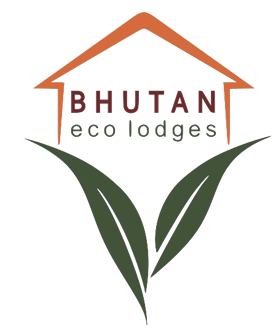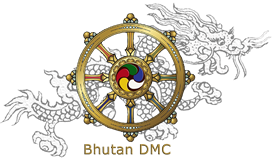Bhutan - East to West Tour
Incredibly scenic road trip from eastern gateway to west Bhutan!
Duration: 12 Nights 13 Days
Places visited: Surface entry via east border Samdrup Jongkhar, Trashigang, Trashigyantse, Mongar via Radi village, Bumthang, Trongsa, Gangtey, Punakha, Wangdue Phodrang, Thimphu via scenic Dochu La, Paro including Tiger’s Nest
Best Seasons to Visit: March to May & September to early December
Moderate Seasons to Visit: January, February, June, July, August & Late December
Trip Grade: Moderate to fairly moderate (Involves long hikes & long drive)
Tour Type/Group Size: Private tour of you and your friends and families only
Special Notes: Itinerary can be fine-tuned depending on your interests
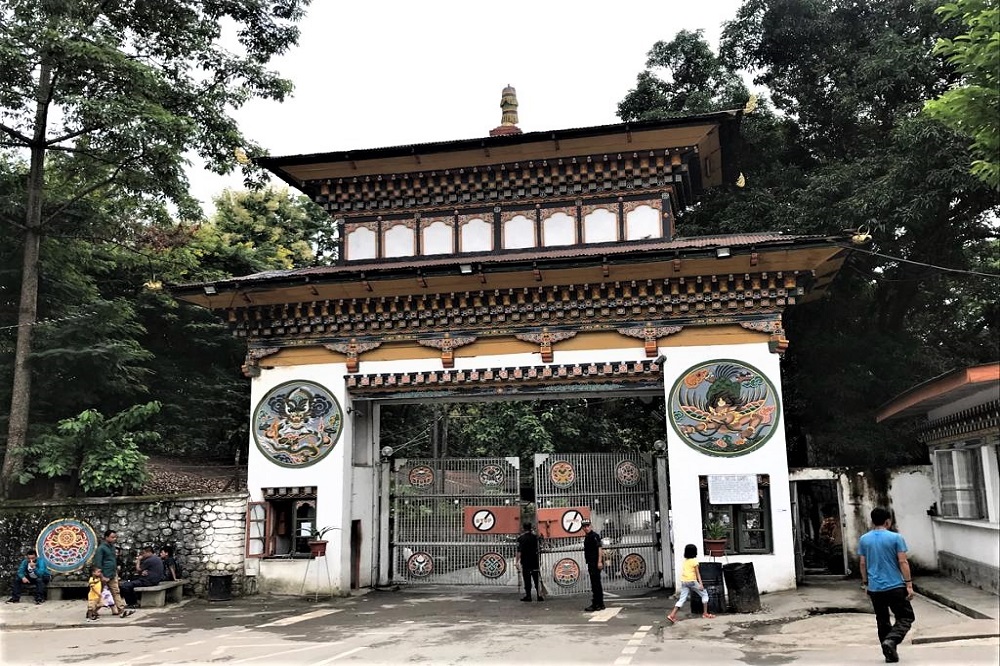
Day 1: Guwahati (Assam, India) - Samdrup Jongkhar (Bhutan) (110 km, approx. 3-hour drive)
On arrival at Guwahati airport, received by our representative and transfer to south-eastern Bhutanese border town of Samdrup Jongkhar that serve as gateway to eastern Bhutan. By far the largest urban centre in eastern Bhutan, Samdrup Jongkhar has been the main trading centre for the eastern Bhutanese and also serves as a convenient entry / exit town for tourists who intend to visit Indian state of Assam and other north-eastern Indian states along with Bhutan.
Samdrup Jongkhar town holds the distinct honour of being the oldest town in Bhutan. Now a days, its still a bustling little settlement serving as a business hub for the five eastern districts of the country namely, Pemagatshel, Trashigang, Trashiyangtse, Lhuentse and Mongar.
Evening take a stroll in heart of town and visit Zangtho Pelri temple representing celestial abode of Guru Rinpoche.
Overnight at the hotel in Samdrup Jongkhar. (Altitude 280m)
Day 2: Samdrup Jongkhar - Trashigang (180 km, approx. 6-hour drive)
After breakfast proceed to Bhutan’s largest eastern town of Trashigang which is located 551km away from Bhutan’s capital city, Thimphu. Once the centre of a busy trade route with Tibet, Trashigang is today the junction of east-west highway with road connecting to Samdrup Jongkhar and then to the Indian States of Assam. This town is also used as the market place for the semi nomadic people from Merak and Sakteng.
En route take a short stop at Khaling. ‘Kha’ in Bhutanese language Dzongkha means ‘Bird’ and ‘ling’ means ‘valley’. This is one of the most enchanting, haunting and lush green fertile valleys, blessed with innumerable variety of birds and their songs. One of the oldest School, established in 1978 is located here known as ‘Jigme Sherubling Higher Secondary School’. At Khaling, we also get opportunity to experience and explore Bhutanese textile weaving.
Drive further via Kanglung town. It is home of Sherubtse college, one of the Royal University of Bhutan’s famous academic institutes.
Later in the afternoon visit Trashigang Dzong (The Fortress of the Auspicious Hill), built in 1659 at the confluence of Gamri Chhu and Dangme Chhu rivers. The Dzong commands a remarkable view over the surrounding countryside and continues to house a thriving monastic community as well as central administration for Trashigang district.
Overnight at the hotel in Trashigang. (Altitude 1,150m)
Day 3: Trashigang (Full day excursion to Trashiyangtse)
After breakfast, visit the temple of Gom Kora, set on a small alluvial plateau, overlooking the river. Located 24 km from Trashigang town, Gom Kora is a famous place, as Guru Rinpoche is said to have subdued a demon here, trapping it in a rock. Then traversing on down the road to Doksum village, where one may see women busily weaving traditional Bhutanese fabric. The road turns into the from hills here, running up the side of a winding river valley to Trashiyangtse.
In former times, Trashiyangtse was an important center because it lies on one of the carvan routes leading from western and central Bhutan. Trasiyangtse is now a rapidly growing town and the administrative center for this district. The area is famous for its wooden containers and bowls, which make inexpensive, attractive and useful souvenirs of a visit to this remote region.
Visit Trashiyangtse Dzong, which overlooks the town and was built in the late 1990s when the new district was created.
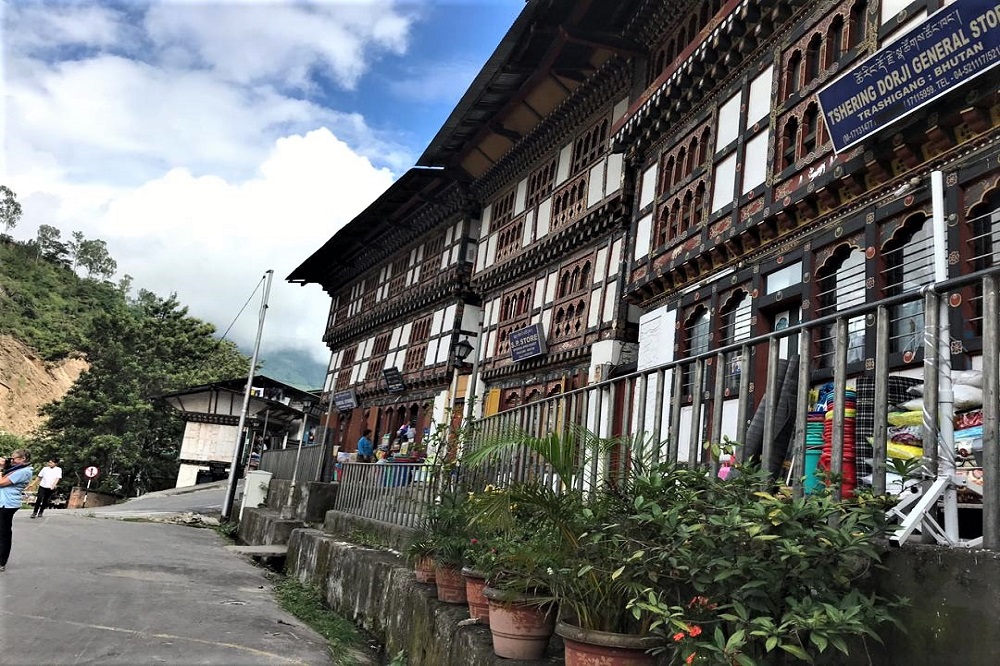
Also visit Chorten Kora. This dazzling white stupa is situated on the riverbank below the town. Constructed in 1740 by Lama Ngawang Loday, it is built in the same style as Bodhnath stupa in Nepal, with eyes painted at the four cardinal points. During the second month of the lunar calendar there is an interesting celebration here, known as 'Kora'.
In the evening, return to Trashigang.
Overnight at the hotel in Trashigang. (Altitude 1,150m)
Day 4: Trashigang – Ranjung & Radhi - Mongar (135 km, approx. 5-hour drive)
After breakfast, a 45-minute drive (16km) through the Chir Pine Forests along the bank of Gamri Chhu river, take travellers to satellite town of Ranjung Woesel Monastery of Dhujom Dharma Linage, founded by the H.E. Garab Rinpoche. Ranjung town is located in the base of deep Chir Pine valley and remains humid and hot during the summer.
Five km ahead of Ranjung, explore Radhi village famous for its rice fields and skill of its weavers. Radhi village (1,570m) is often called ‘Rice Bowl of the East’ owing to lush green paddy fields that supply rice to almost entire eastern part of the country. During off-agricultural season the village folks engage in textile weaving using traditional back-strap loom and traditional dyes. Notably, Radhi village produces some of the most authentic high quality raw silk textiles to be found anywhere in Bhutan.
Later proceed to Mongar, the second largest town in the sub-tropical east, Mongar like Trashigang, is situated on the side of a hill in the contrasts to other towns of Western Bhutan which are situated on the valley floor.
Visit Mongar Dzong, one of the newest Dzong in the country established in 1930 to replace the original Shongar Dzong. Importantly the original Utse (central tower) dates from an earlier age only. There are four Lhakhangs (temples) in the Utse, including a goenkhang (chapel dedicated to protective deities) and the Sangay Lhakhang.A visit to Dzong, gives visitors an impression of how traditional Bhutanese architecture has continued to thrive through the centuries.
Evening at leisure in Mongar town, to explore its quaint & colourful market.
Overnight at the hotel in Mongar. (Altitude 1620m)
Day 5: Mongar – Ura Valley - Bumthang (Jakar) (196 km, approx. 7-hour drive)
After breakfast embark on an exciting and scenic journey to Bumthang. It is one of the most beautiful drive in the Himalayas across 4,000m high Thrumshing la (pass). Gushing waterfalls, steep cliffs with even steeper drops, blazing flowers and constantly changing vegetation combine to make this journey as varied as it is beautiful.
En route visit fascinating Ura valley (3100m), the highest of the four Bumthang valleys. Ura is one of the most picturesque villages in Bhutan having about 50 closely packed houses along cobblestone streets. Take a walk in the beautiful village and also visit Ura Lhakhang (temple) dedicated to Guru Rinpoche. Inaugurated in 1986, it contains a huge statue of the master and remarkable paintings of the cycle of his teachings. Since last few decades, Ura has been transformed from a marginal community to a prosperous valley.
Traversing further for about 48km and one-and-a-half-hour drive, takes one to Choekhor valley of Bumthang which is the heart of Bumthang town.
Overnight at the hotel in Bumthang. (Altitude 2600m)
Day 6: Bumthang
Morning after breakfast, proceed to visit Jambay Lhakhang. This ancient temple believed to have been built in 659 by Tibetan King Songtsen Gampo on the same day as Kyichu Lhakhang in Paro. It is one of the 108 monasteries built by him to subdue evil spirits in the Himalayan region. Its present architectural appearance dates from the early 20th century.
Drive onwards for less than 10 minutes to visit Kurje Lhakhang, consisting of three temples. The one on the right was built in 1652 on the rack face where Guru meditated in the 8th century. Second temple is built on the site of a cave containing a rock with the imprint of Guru's body and is therefore considered the most holy. The third temple was built in 1990s by Ashi Kesang, the Queen Mother. These three temples are surrounded by a 108 chorten wall.
Jakar Dzong, founded by great grandfather of the first Zhabdrung is next in sightseeing schedule. This Dzong was initially built as a monastery in 1549. It was upgraded after the Zhabdrung had firmly established his power in 1646. The Dzong is now used as administrative centre for Bumthang valley, and also houses the regional monk body.
Post lunch, get an insight into textile weaving at Dorbji Weaving Centre, housing about a dozen looms.
Then pay a special visit to Bumthang Brewery. At this state-of-the-art mincobrewery one can learn about the brewing of Swiss-style unfiltered Weiss beer, and also sample end product in adjacent Panda Beer Garden Café.
Later in the evening visit to Tamshing Lhakhang. Located across the river from Kurje Lhakhang, this temple was founded in 1501 by Terton Pema Lingpa, the re-incarnation of Guru Padmasambhava. The monastery has very ancient religious paintings like 1,000 Buddhas and 21 Taras (female form of Buddhistava). The temple was restored at the end of the 19th century.
Overnight at the hotel in Bumthang. (Altitude 2,600m)
Day 7: Bumthang - Trongsa - Gangtey (Phobjikha valley) (153km, approx. 6-hour drive)
After breakfast embark on a fascinating journey to Gangtey via Trongsa.
Drive from Bumthang to Trongsa is 68km (approx. 2.1/2-hour) amidst spectacular landscape and crosses 3,400m Yutongla pass. Trongsa town, perched on steep slopes above a river gorge, forms the central hub of the nation and is the place from where attempts at unifying the country were launched.
In Trongsa, visit Ta Dzong, once a watchtower which historically guarded Trongsa Dzong from internal rebellions. Standing on a promontory above the town, it was built by Chogyal Minjur Tempa, the first Governor of Trongsa, in 1652. Today, Ta Dzong has been converted into a state-of-the Art Museum with technical and financial support provided by Austria t. A visit to this former watchtower provides visitors an insight into the significance of Trongsa in Bhutan’s history.
Then visit majestic Trongsa Dzong, built in 1648. It is the largest fortress in Bhutan which stands on a spur overlooking the gorge of the Mangdi Chhu river. The Dzong is the massive structure with many levels, which slope down the contours of a hill on which it perches. Because of its highly strategic position as the only connecting route between east and west,
it used to be the seat of power over central and eastern Bhutan and the vanguard of the warriors. All the Kings of Bhutan first served as the Trongsa Penlop (Governor) before ascending the Raven Crown throne. Trongsa Dzong remains one of the most aesthetic and magnificent works of traditional Bhutanese architecture.
Afterwards drive onwards to Gangtey across Pelela pass (3,300m), the traditional boundary between east and west. The pass is marked by a large prayer flag and the ground is covered with high altitude dwarf bamboo. Stop en route at Chendbji Chorten, the stupa built in 18th century by a Lama named Shida. It is Nepalese in style with eyes painted at four cardinal points.
Overnight at the hotel in Gangtey (Phobjikha valley). (Altitude 3,000m)
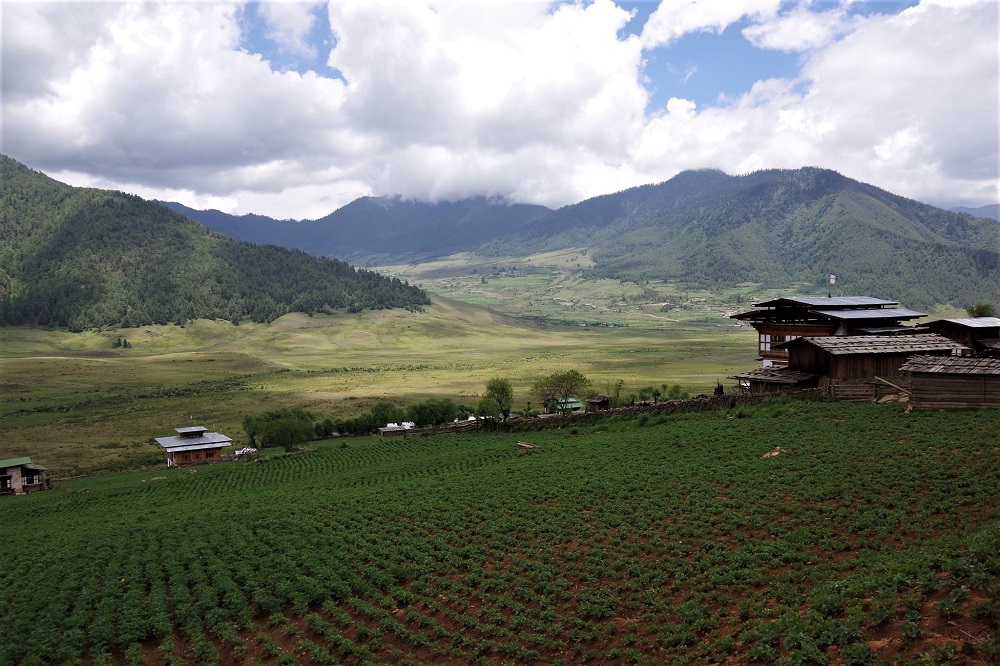
Day 8: Gangtey – Wangdue - Punakha (85km, approx. 3-hour drive)
Morning visit Gangtey Goempa. Perched on a small hill that rises from the valley floor, the Gangtey Monastery is the only Nyingmapa monastery on the western side of the Black Mountain’s and also the biggest Nyingmapa monastery in Bhutan. The Monastery is home of Gangtey Tulku, a highly respected reincarnate lama and its complex also includes a school, meditation facilities and residential quarters for monks. A charming, quaint village surround the monastery which is mainly inhabited by the families of the 140 Gomchens who take care of the Monastery.
After this spiritual immersion, commence exploration of fascinating Phobjikha valley. Phobjikha is a U-shaped valley, which is surrounded by the irregular formation of mountains carved by the glacial action. A designated conservation area, the valley is winter home of the endangered, black-necked crane those migrate from the arid plains in the north to pass winter in milder and lower climate. At an elevation of 3,000m, Phobjikha falls under the district of Wangduephodrang and lies on the periphery of the Black Mountain National Park. The valley boasts two beautiful meandering rivers, Nakay Chhu (Chhu Naap-black water) and Gay Chhu (Chhu Karp-white water).
Also visit Black Necked Crane Information Centre. Situated on the edge of the forest and wetland along the main road of Phobjikha valley, the black-necked crane information Centre has an observation room equipped with high power telescope and spotting scopes for catching the best view of the cranes. The centre also offers display information that outline the natural and cultural history of the area.
After lunch drive to Punakha via Wangdue, taking a stroll in and around this newly developed city Centre.
Overnight at the hotel in Punakha. (Altitude 1,300m)
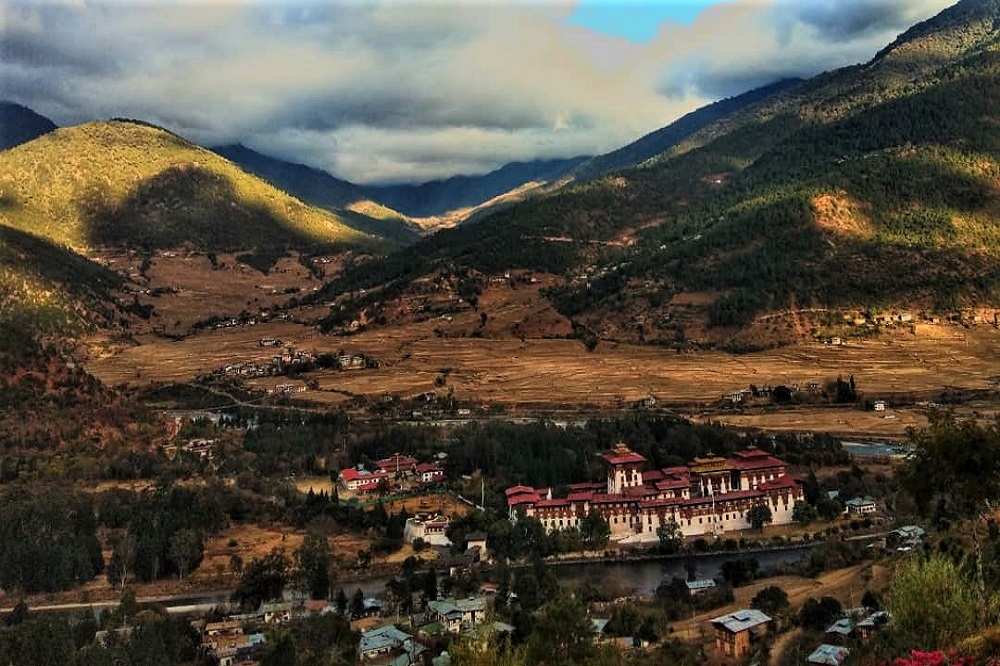
Day 9: Punakha - Thimphu (75 km, approx. 2.1/2-hour drive)
Post breakfast, visit Punakha Dzong. Also known as ‘The Palace of Great Bliss’, Punakha Dzong was built strategically at the junction of Pho Chhu and Mo Chhu rivers in 1637 by Zhabdrung Ngawang Namgyal to serve as the religious and administrative centre of the region. The Dzong has played an important role in Bhutan’s history and on 17 December 1907, the first King of Bhutan Gongsar Ugyen Wangchuk, was crowned here. Damaged by six catastrophic fires, an earthquake and once by flood, the Dzong has been fully restored by the fourth King. Dzongchung (or the little Dzong), built in 1328 by saint Ngagi Rinchen can still be seen opposite the main Dzong.
Then embark on a short walking excursion to Chimi Lhakhang:
The Chimi Lhakhang (temple), situated on a round hillock in the centre of Punakha valley near Lobesa, was built in 1499 by the 14th Drukpa hierarch, Ngawang Choegyel, after the site was blessed by the maverick saint Drukpa Kuenley who in the late 15th century used humour, songs and outrageous behaviour to dramatise his teachings and owing to this also known as ‘Divine Madman’. The Lhakhang is situated about 10 km from centre of Punakha town near Sopsokha village, from where a 20-minute walk through fields of mustards and rice, leads to a hillock that is the site of temple. Prayer flags are lined all along the road from the tiny village hamlet known as Yowakha, along a stream to the monastery. All houses in the village are decorated with paintings of phalluses on their exterior walls. The lama Kuenley had called the hillock where the monastery exists as the breast of a woman because of its round shape.
After lunch, drive to Bhutan’s capital city Thimphu via Dochu La.
Dochu-la pass located at a height of 3,088m/ 10,130 ft is a scenic location with chortens chorten, mani wall, and prayer flags which decorate the highest point on the road. If skies are clear, it may be possible to see the following peaks from this pass in the order left to right: Masagang (7,158m), Tsendagang (6,960m), Terigang (7,060m ), Jejegangphugang (7,158 m), Kangphugang (7,170 m ), Zongphugang (7, 060 m ), a table mountain that dominates the isolated region of Lunana - finally Gangkar puensum, the highest peak in Bhutan at 7,570m, after this uplifting experience return to Punakha.
On arrival in Thimphu check into the hotel. Later in the evening visit Memorial Stupa, built in 1974 to honour the Third King, Druk Gyalpo, Jigme Dorji Wangchuck (1928-1972). The stupa is a prominent landmark in the city with its golden spires and bells. In 2008, it underwent extensive renovation. This stupa is unlike others as it does not enshrine human remains and only Druk Gyalpo’s photo in a ceremonial dress adorns a hall on ground floor. When he was alive, His Late Majesty Jigme Dorji Wangchuk wanted to build a chorten to represent the mind of Buddha.
Later enjoy a stroll walk around Thimphu city centre.
Overnight at the hotel in Thimphu. (Altitude 2320m)
Day 10: Thimphu
Morning after breakfast, drive to see the iconic gigantic Buddha Dordenma (Vajra seated), the world’s largest sitting bronze statue. Majestically situated at Kuenselphodrang, it is an object of great veneration to all sentient beings. The land at Kuenselphodrang measuring 145 acres was gifted to Monks Body by His Majesty the Fourth King of Bhutan. The Park conserves 798.4 acres of forest area that surrounds the Buddha Dordenma statue. Dedicating it to the 60th birth anniversary celebration of His Majesty the Fourth Druk Gyalpo, His Holiness the Je Khenpo consecrated the 201 feet tall Buddha Dordenma statue at the Kuenselphodrang on 24th September 2015.
After this insightful visit drive to Textile Museum, established in 2001 under the royal patronage of Her Majesty Gyalyum Sangay Choden Wangchuck. The museum is managed by the Department of Culture, Ministry of Home & Cultural Affairs, Royal Government of Bhutan. Exhibitions here introduce the major weaving techniques, styles of local dress and textiles made by women and men.
Institute for Zorig Chusum, commonly known as Arts & Crafts School or Painting School is an important learning center that offers a six-year course on the 13 traditional arts and crafts of Bhutan. On a visit, one can see students learning the various skills taught at the school.
Located below the main town, Centenary Farmers Market popularly known as Weekend market is a pleasant, colourful & delightful place to mingle with locals. Farmers come from all over the country to sell their farm products in this market. Also available here are the handicrafts and artifacts, to purchase.
Then visit Changangkha Lhakhang, one of the ancient temples in Thimphu established on a site chosen by Phajo Drukgom Shigpo, the founder of Drukpa lineage in Bhutan. The central statue here is Chenrezig in a manifestation with 11 heads. From temple courtyard, there is fascinating view of Thimphu valley.
Conclude the sightseeing of the day with visit of Trashichhoedzong that has been the seat of the government since 1952 and presently houses the throne room and offices of His Majesty the King, the Secretariat and the Ministries of Home affairs and Finance. The dzong is located close to Thimphu town, next to the banks of the Wang Chhu River. It is an impressively large structure, surrounded by well-kept lawns and beautiful gardens.
Evening free to explore the government-run Handicrafts Emporium and local crafts Bazaar, to browse through example of Bhutan's fine traditional arts constituting hand-woven textiles, thangkha paintings, masks, ceramics, slate and wood carvings, jewellery, interesting items made from local materials.
Overnight at the hotel in Thimphu. (Altitude 2,320m)
Day 11: Thimphu - Paro (55km, approx. 1.1/2-hour drive)
After breakfast, continue fascinating journey towards Paro, en route visiting Simtokha Dzong, one of the oldest fortresses of the country, built in 1629. Legend associated with dzong’s construction mention that the fortress was built to subdue a demon that was harassing travellers to this region. The most noteworthy artistic feature of this dzong is the series of over 300 finely worked slate carvings behind the prayer wheels in the courtyard.
Then drive onto Paro, on the way taking a photo stop at Chuzom, the confluence of Paro & Thimphu rivers.
Traversing onward, visit Tamchog Lhakhang, a temple dedicated to 13th century saint Thangthong Gyalpo, who is famously known as iron bridge builder in Bhutan. The temple is located across the river and in order to reach the temple one need to cross an iron bridge, one of the few remaining of the many that Thangthong Gyalpo built. Crossing the traditional iron bridge with its swaying and undulating movements is quite an experience.
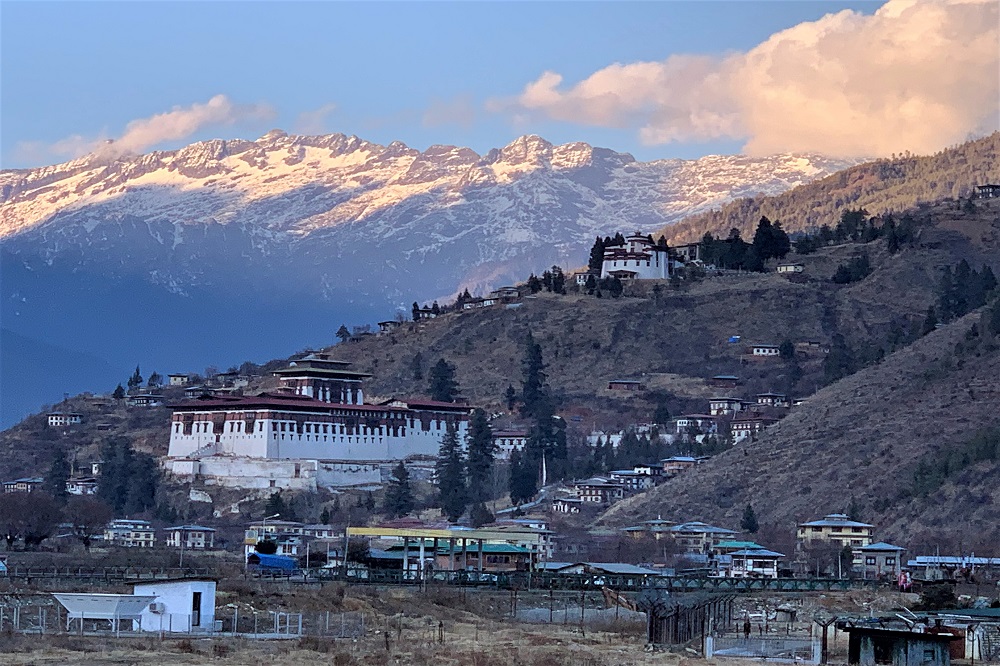
Arrive in Paro and check in at your hotel. This afternoon is dedicated to exploring Paro and its surrounding.
Afternoon visit Ta Dzong, originally built as Watchtower, which now houses National Museum. This seven-storied watch tower fortress or Ta Dzong was built in 1649 and during 1968 converted into National Museum of the country. The extensive collection includes antique thangkha paintings, textiles, weapons & armour, household objects and a rich assortment of natural and historic artifacts.
After the visit, walk down the trail to explore 17th century Rinpung Dzong, meaning (‘Fortress of the heap of jewels’), which has a long and fascinating history. The Dzong ranks as a high point of Bhutanese architecture. Its massive, buttressed walls that tower over the town are visible through the valley. Inside Rinpung Dzong are 14 shrines and chapels including Sandalwood Stupa, Protector’s shrine, Temple of the Guru’s eight manifestations, Chapel of the head lama, Chapel of the eleven-faced Avalokiteshvara, Temple of the Treasure Revealer, Temple of the Bursar.
Overnight at the hotel in Paro. (Altitude 2,280m)
Day 12: Paro
After breakfast, the morning is reserved to visit Taktsang Monastery (approx. 5 hour walk), one of the fabulous locations in the known world. The Taktsang Monastery is the most famous of Bhutan’s monasteries, perched on the side of a cliff 900m above the Paro valley floor. It is said that Guru Rinpoche arrived here on the back of a tigress and meditated at this monastery and hence it is called ‘Tiger’s Nest’. This site has been recognized as a most sacred place and visited by Zhabdrung Ngawang Namgyal in 1646 and now visited by all Bhutanese at least once in their lifetime. On 19 April 1998, a massive fire had severely damaged the main structure of building but later this Bhutanese jewel got restored to its original splendour.
Afternoon drive to the base of Drukgyel Dzong, a ruined fortress where Bhutanese warriors fought Tibetan invaders centuries ago. The snowy dome of sacred Chomolhari, ‘mountain of goddess' can be seen in all her glory from the approach road to the Dzong. Nearby visit a traditional farmhouse, which offers deep insight into lifestyle of village folks.
While returning to the hotel, en route visit the 7th century Kyichu Lhakhang, one of the 108 temples built in the Himalayas by Tibetan King, Songtsen Gampo. The building of this temple marks the introduction of Buddhism in Bhutan.
Overnight at the hotel in Paro. (Altitude 2,280m)
Day 13: Depart Paro
After breakfast, transfer to the airport for flight to onward destination. Our representative will help you with exit formalities and bid you farewell.
HOTELS IN THIMPHU
HOTELS IN PUNAKHA & WANGDUE
HOTELS IN GANGTEY
HOTELS IN TRONGSA
HOTELS IN BUMTHANG
HOTELS IN MONGAR
HOTELS IN TRASHIGANG
HOTELS IN SAMDRUP JONGKHAR
HOTELS IN PHUENTSHOLING
HOTELS IN HAA
HOTELS IN GELEPHU
HOTELS IN ZHEMGANG
RESTAURANTS IN PARO
RESTAURANTS IN THIMPHU
RESTAURANTS IN PUNAKHA
TOUR ITINERARIES
TREKKING ITINERARIES
SPECIAL INTERESTS TOURS
UNIQUE FESTIVALS & FAIRS
BLOG

